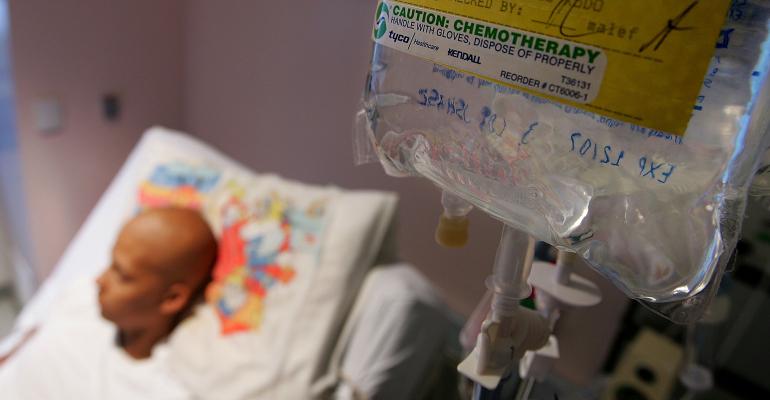One of your high-net-worth clients is newly diagnosed with cancer. In your professional role, what are the best things you can do to help?
Here’s one answer, and for almost 100 ultra-high-net worth cancer patients, it’s proven to be both an unusually useful and valuable answer. It’s about helping your client find the best treatment options in the shortest time. Under most circumstances, finding the most qualified specialists is a slow and cumbersome process. Patients typically spend months traveling around the country, seeking opinions and then second or third opinions. Meanwhile, they’re dealing with not only the anxiety of their illness, but also with the fact that the different specialists often have conflicting recommendations. Time is passing, and the malignancy is growing. Fortunately, you can offer your client a highly effective and innovative answer to this difficult situation: Cancer Panels.
In as little as two to four weeks, a panel of 10 or more of the world’s greatest cancer experts can be convened to study your client’s case. They’ll discuss it for three to four hours and then provide a consensus recommendation to your client’s attending physician. The panelists come to New York or Washington from some of the world’s leading cancer and medical centers including: Memorial Sloan-Kettering, M.D. Anderson, Johns Hopkins, Mayo Clinic, Dana-Farber, Harvard, Yale, University of Washington, UCLA, University of California at San Francisco, Duke University, University of Chicago and others, in both the U.S. and overseas.
This program was created 12 years ago by businessman Jim Martell when a close friend was diagnosed with a rare sarcoma cancer. At that time while searching for leading oncology experts, Martell met Dr. David Sidransky from Johns Hopkins. Sidransky is one of the world’s leading cancer authorities in the field of molecular diagnostics, targeted therapies and individualized patient treatments. Martell understood the need for rapid, authoritative, consensus recommendations, and Cancer Panels was the result. Dr. Sidransky has chaired all the panels since then. To see how an actual cancer panel works, let’s take the case of Elena Anderson. (This is not her real name and some of her case details have been disguised to protect her privacy.)
A Manhattan Project for Elena Anderson
Anderson is a 35-year-old mother with three pre-teen girls. She’s also a British citizen, and she has glioblastoma. The standard of care for her cancer is immediate surgery followed by extensive radiation. She and her husband came to Martell, asking him to assemble a Cancer Panel to see if there were any good alternatives. Martell and Sidransky quickly assembled a 12-member panel of world experts on glioblastoma.
Physicians and cancer researchers flew to Manhattan from Zurich, Tel Aviv, London, and from all over the United States. Anderson’s husband and rabbi flew from London to attend, although she herself did not. Before the panel began, the husband explained to the panelists why his wife badly wanted to avoid surgery. She feared that cutting out the tumor, given its size and location, could mean she would lose 30 IQ points. “Her deepest fear,” he summarized, his voice choking, “is that surgery could mean she would no longer be a competent mother to our girls.”
The panel settled in to evaluate Anderson’s case. They were sitting around an oval table, with the husband and rabbi sitting at the side of the room. The first hour of the four-hour panel consisted of going over the clinical facts. The panelists studied a screen that projected the results of the MRIs, genetic testing, the volumetrics of the lesion, and a hundred other technical details. By the second hour, they were discussing actual treatment. One expert was particularly focused on the volume of blood feeding the tumor.
“Because the volume of blood reaching the tumor is very small,” he told his fellow panelists, “it’s going to be slow-growing. We have time to look at options other than surgery.”
Another expert spoke about the edges of the tumor. “The margins are smooth. As of now, it’s not spreading.”
Still another doctor said the tumor’s slow growth meant trying immunotherapy as a good option. Some of his as-yet unpublished research showed that Anderson’s genetic profile was favorable for immunotherapy.
At the end of the four hours, the glioblastoma experts were able to deliver the good news that even though surgery and radiation would normally have been the standard of care for someone with Anderson’s symptoms, she could almost certainly avoid both. The panelists recommended other treatments that were likely to mean a better outcome.
Each Case Is Unique
Martell is careful not to overpromise, and your client’s experience will be different from Anderson’s. “I can’t promise any future client anything except that renowned doctors will come up with what in their opinion is the best treatment recommendation and hopefully this will help gain time and quality of life for the patient.”
He goes on to say, “Medicine is currently advancing by the minute, and with the extra time that a panel could provide, the next lifesaving treatment on the horizon may become available.”
If you have a client who would benefit from knowing more about cancer panels, consider visiting www.cancerpanels.com or telephone Jim Martell at 703-919-9945.
Mitzi Perdue is a business owner, speaker and author of the book, How to Make Your Family Business Last. Contact her at [email protected] or call her at 410-860-4444.





